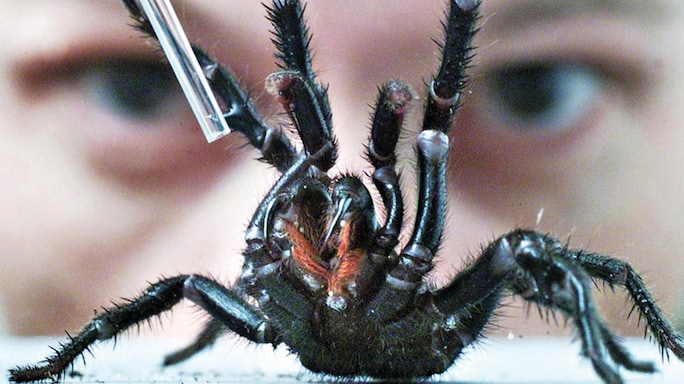Spider Bite!
A single wrong move almost cost construction worker Adrian Main his life
 PHOTO: G Fairfax Media via Getty Images; A researcher at the Australian Reptile Park undertakes the delicate job of ‘milking’ venom from a funnel-web spider.
PHOTO: G Fairfax Media via Getty Images; A researcher at the Australian Reptile Park undertakes the delicate job of ‘milking’ venom from a funnel-web spider.
It was unseasonally hot approaching the 2016 Easter long weekend in the Australian state of New South Wales. By mid-afternoon on Thursday, the sun was beating down and the clear blue skies showed no signs of the forecast rain. Adrian Main was doing what he loved, working outside in the rugged bushland that surrounds the leafy suburbs on the northern outskirts of Sydney.
Guided by his love of mountain-bike riding, Adrian had founded Synergy Trails, a construction company that specialized in installing narrow, winding dirt-bike trails in bushland for weekend and competition riders. It was dusty, dirty work at times, but with the trees providing shade and the only noise coming from his team and the local birds, there wasn’t any place he’d rather be.
Over the years, the 40-year-old had encountered hazardous fauna while digging around in soil, including venomous arachnids and snakes, but he knew how to distinguish the non-threatening ones from the dangerous ones. Adrian was trained in first-aid, though he never seriously thought he'd need it.
With the clock ticking down towards the start of the four-day long weekend, Adrian had only a small digging job left to do. His shovel was in his vehicle, parked some 50 metres away. He considered getting it, but the job was small, and only a light dig was necessary to get beneath the shallow soil and leaf litter. So he used his hands instead. Just as his fingers slid under the pile of leaves, he felt a sharp, deep pain in his left hand. Adrian quickly pulled out his hand to see a spider gripping his left index finger. The five-centimetre-long glossy black creature had its fangs firmly embedded into the skin, piercing through to his knuckle. The pain felt as if a nail was being hammered into his finger.
But that wasn’t the worst of it. Adrian knew immediately that the spider wrapped around his finger was a Sydney funnel-web (Atrax robustus). He frantically flicked his hand up and down to throw off the spider, but it didn’t move. He persisted, shaking his hand even harder and, after three or four seconds, it finally let go of its grip and dropped to the ground at Adrian’s feet. He looked down just in time to double-check the spider’s identity before it buried itself back under the leaf litter. It was a fully grown male Sydney funnel-web, the deadliest spider in Australia.
After 15 years working in the bush, encountering different types of spiders and snakes, Adrian never imagined he’d get bitten. But all it took for him to become a victim was one brief moment when he was rushing to finish a simple job. He called out to his crew mate, Phil, who was working close by. Phil dropped his shovel and ran over. The pair calmly walked to the four-wheel-drive while Adrian pinched down hard at the base of his knuckle to slow the spread of venom into his bloodstream. They both knew a bite like this, if left untreated, could cause death within an hour.
Fortunately, the trail where they had been working was not very far from Hornsby Ku-ring-gai Hospital. Regardless, Phil raced through the off-road terrain, jostling them about inside the cab. Once they reached the suburban streets, he took a shortcut: he mounted a sidewalk to reach the main road as quickly as possible. He needed to get his boss to hospital as fast as he could. Adrian walked into the emergency department with blood still streaming down his finger. He calmly told the triage nurse at reception that he’d been bitten by a funnel-web, and was quickly brought to a bed. He felt lightheaded and strange, as if he was going to pass out at any minute, but he was coherent enough to talk with the nurses, who had hooked him up to an array of monitors to start assessing his vital signs. During summer, the emergency-care unit at the hospital treats patients with spider bites about once a week, but only rarely do patients have symptoms of envenomation, or venom poisoning. Still, they waited and watched.
About 10 minutes after arriving at the hospital, Adrian suddenly became incoherent and couldn’t finish his sentences. Then his face and tongue started twitching, he felt nauseous and he began sweating and drooling. Dr Clare Skinner, director of emergency medicine at Hornsby Ku-ring-gai Hospital, explained to Adrian that his system was starting to react to the funnel-web venom. It was time to give him the first of two vials of anti-venom. If his symptoms and vital signs didn’t improve, the emergency staff were ready with two more vials to repeat the procedure.
Less than an hour’s drive north of the hospital where Adrian was being treated is the Australian Reptile Park (ARP), one of the Sydney region’s major tourist attractions. Behind closed doors, the staff perform a service that keeps individuals safe from death’s door if they find themselves, like Adrian, unlucky enough to be bitten by a male funnel-web spider. That service? Extracting deadly venom.Since the 1980s, the ARP has been ‘milking’ arachnids and sending the poison to a lab where it’s turned into antivenom. Milking the spiders is not for the faint-hearted, but ARP staff are not like most people. They care about their spiders in a similar way to how we might care for a pet. They keep the spiders in ideal conditions—moist, humid enclosures—and feed them crickets and cockroaches. Their ultimate goal is to keep people safe from harm.
The natural habitat of Australia’s funnel-web spiders is humid forests, but they can be found in any shady, well-vegetated place. They dig burrows up to 60 centimetres long, which they line with their silk webbing. Of all the funnel-web species, the Sydney variety is the most aggressive and the only one that can cause fatalities in humans. Each year between 30 and 40 people in Australia are bitten by funnel-web spiders. After a total of 13 recorded deaths and years of research, an anti-venom was developed in 1981.
 The spiders’ funnel-shaped burrows are lined with their silk webbing; PHOTO: ©andrew merry/getty images
The spiders’ funnel-shaped burrows are lined with their silk webbing; PHOTO: ©andrew merry/getty images
Here’s how: When disturbed, a funnel-web spider will rear up in a defensive position, raising its front legs, ready to strike with its fangs. This stance is what ARP ‘milkers’ need to extract the lifesaving poison. “We gently tickle the spider with a pipette, which is a glass cylinder like a straw with a funnel on the end,” says Tim Faulkner, general manager and head of conservation at ARP. “The spider rears up, and a tiny droplet of venom is produced on each fang. At that point we put the funnel part of the pipette near the venom and it is collected.” Spiders are milked once a week. To produce a vial of the funnel-web anti-venom, such as the one that Dr Clare Skinner gave to Adrian Main, a spider needs to be milked between 50 and 100 times. And this is where it gets complicated for Faulkner and his team.
The natural life expectancy of male funnel-web spiders is just four years, and they don’t mature until they’re at least three years old, which gives ARP—the sole supplier of funnel-web venom in the world—between six and 12 months to extract the spiders’ venom. “We only milk mature male funnel-webs, because the male is six times more venomous than females. And the anti-venom is made to combat male venom,” says Faulkner. If an adult man needs at least two vials of anti-venom to reverse the effects of a bite, that’s a whole lot of spiders to milk. This is why Faulkner is always looking for volunteers to collect male funnel-web spiders for his milking programme. “We rely on the community, the beneficiaries of the programme, to get spiders to us,” he says. Unlike the female spider, which spends her entire life underground, the male spider wanders above ground, so his whereabouts is more unpredictable.
After being observed for 24 hours, Adrian was discharged from hospital and allowed to go home. The first thing he did was pack the car, so he and his family could set off on the Easter weekend camping trip they had planned. For an outdoorsy person like Adrian, taking a camping holiday away from civilization didn’t feel risky. “For me, it wasn’t a big issue,” he says. But, he does admit that he noted where the closest hospital was.
Although pain is usually the main ongoing symptom from funnel-web bites, Adrian refused to take painkillers because they don’t agree with him. Still, he felt nauseous and a little dozy, and it took another three weeks before his full strength returned. Since being bitten, Adrian does a couple of things differently. He always uses a shovel when digging, and he and his team catch funnel-webs whenever they can and deliver them to the ARP. “That anti-venom saved my life—and may save it again one day.”






